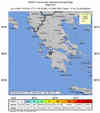Magnitude 6.4 - GREECE
2008 June 08 12:25:30 UTC
Earthquake Details
| Magnitude | 6.4 |
|---|---|
| Date-Time |
|
| Location | 38.000°N, 21.468°E |
| Depth | 16 km (9.9 miles) set by location program |
| Region | GREECE |
| Distances | 35 km (20 miles) SSW of Patras, Greece 120 km (75 miles) NNW of Kalamata, Greece 195 km (120 miles) W of ATHENS, Greece 195 km (120 miles) SSE of Ioannina, Greece |
| Location Uncertainty | horizontal +/- 2.9 km (1.8 miles); depth fixed by location program |
| Parameters | NST=554, Nph=554, Dmin=6.5 km, Rmss=1.36 sec, Gp= 25°, M-type=centroid moment magnitude (Mw), Version=Q |
| Source |
|
| Event ID | us2008taaw |
- This event has been reviewed by a seismologist.
- Did you feel it? Report shaking and damage at your location. You can also view a map displaying accumulated data from your report and others.
Earthquake Summary
Felt Reports
Two people killed, at least 240 injured and at least 1,156 buildings damaged or destroyed in Achaia and Ileia. Felt (VIII) at Kato Achaia; (VII) at Patrai and Rion; (VI) at Agrinion; (V) at Corinth, Tripolis and Zakynthos; (IV) at Agia Paraskevi, Aigina, Argostolion, Athens, Ioannina, Kallithea, Karditsa, Kifisia, Nydri, Preveza, Trikala and Volos; (III) at Amarousion, Galatsion, Glifadha, Kalamakion, Khalandrion, Larisa, Nea Erithraia, Nea Ionia, Nea Smirni, Nikaia, Palaion Faliron and Piraeus; (II) at Aigaleo, Chani, Korydallos and Voula. Felt in most parts of Greece. Also felt at Tirana, Albania; Barletta, Brindisi, Cosenza, Lecce, Matera, Naples and Taranto, Italy; Ohrid, Macedonia.
Tectonic Summary
The earth's crust and lithosphere in the eastern Mediterranean constitute a broad boundary region between three major tectonic plates, the Eurasia, Africa, and Arabia plates. The motions of these major plates drive smaller microplates, and it is the shapes and motions of these smaller plates that determine the locations and focal mechanisms of most intraplate earthquakes in the region.
The earthquake of June 8, 2008, was generated by stresses resulting from the motion of the small Aegean Sea plate southwest with respect to the Eurasia plate with a velocity of about 30 mm/y. The boundary between the Aegean plate and the Eurasia plate in central Greece is diffuse. Seismicity is concentrated in east-trending and northeast-trending zones of deformation. The east-trending zones are characterized by predominantly normal faulting. The northeast-trending zones are characterized by predominately strike-slip faulting earthquakes. The focal-mechanism of the earthquake of June 8 is consistent with the shock having been caused by strike-slip faulting similar to that occurring within the northeast-trending zones. Since the beginning of the twentieth century, the largest crustal earthquakes of central Greece have had magnitudes of about 7.2.
Earthquake Maps
Scientific & Technical Information
Additional Information, News Reports
- Preliminary Earthquake Report
- U.S. Geological Survey, National Earthquake Information Center:
World Data Center for Seismology, Denver

 Feeds & Data
Feeds & Data










